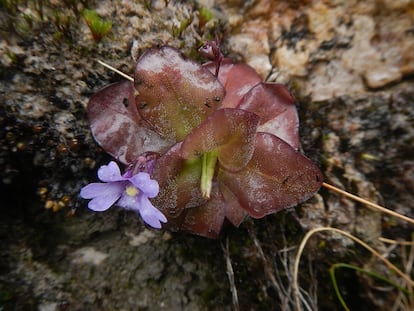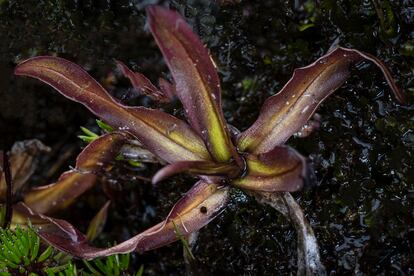Professor Álvaro Pérez and his expedition companions walked for three consecutive days to reach the Cerro Platado Reserve, the highest part of the Cordillera del Condor on the Ecuador-Peru border. This is the second time a team of scientists is visiting the place. The mission of the expedition was to collect a large number of endemic plant species of this unexplored ecosystem. “When we were at the top of the mountain, in the middle of a granite rock canyon, we saw something strange and beautiful that we had never seen before,” Professor Perez recalled with emotion. A small carnivorous plant sprouted from the rock walls, with tiny hairs on its brown leaves and a purple flower. Perez and his colleagues took photographs, collected several samples, and took them to the laboratories of the Pontificia Universidad Católica del Ecuador in Quito. The first trip was carried out in 2016 and the last, in 2021.
At first glance, Perez and his teammates knew they had something different on their hands. They studied its roots, leaves and flowers in detail and discovered that it was a species unknown to science until then. They called her Pingucula ombrophylla. “SIts name means rain-loving or moisture-loving,” explains Pérez, a professor at the School of Biology at the Catholic University, in an interview with EL PAÍS. It is a tribute to the tops of the Cordillera del Canter, full of moss, fog and icy winds. The findings were published last week A scientific journal article Phytokeys, Perez signed; Francisco Tober, Scientist of the National Herbarium of Ecuador; Kevin Burgess, researcher at Ohio State University – Columbus in the US; and Thilo Henning, one of the world’s leading experts on carnivorous plants, from the Leibniz Center for Agricultural Landscape Research in Germany.

Apart from discovery Pingucula omprophilla, The article also describes the discovery of another new species of carnivorous plant from Ecuador Pingucula zimburensis. The species is named after the black lagoons of Zimbura, a highland in Yaguri National Park. Professor Perez and his colleagues first spotted it on the ground while walking a path around the ponds. “It’s in a wet wasteland on the border with Peru,” he says. An interesting aspect of this new species is its leaf morphology. “It differs from other similar plants because its leaves are long and red, which helps protect the plant from solar radiation in the moors where it lives”, explains the scientist.
habitat Pingucula zimburensis It is a marshland. It lives on with lots of mosses and small shrubs, including the valerian species discovered a few months ago. The plant has a maximum size of eight centimeters. It is a terrestrial herb with red leaves and purple flowers that attract small diptera, small flies that fly and fall on its leaves with the wind. The two new species capture their prey in a specific way. “Their leaves have some glandular hairs that release a sticky liquid that traps and kills insects that come near it,” explains the researcher. Decomposing, the tiny flies release nitrogen from their exoskeleton. Plants absorb nitrogen as an essential element for their life cycle.

Newsletter
Analysis of current events and Colombia’s best stories in your mailbox every week
get
The paper describes the findings as follows: “We document two new endemic species Binguilla from southern Ecuador as a result of recent botanical studies. We perform detailed morphological analyzes for these new species, provide a taxonomic description, provide images of all floral and vegetative structures of the plants, and provide a distribution map. The conservation status of the newly described species and their relationships with others are discussed.
Professor Perez says the cinematic concept of plants that attract brightly colored insects and eat them is based on reality, but refers to another family of carnivores. “This is how the famous Venus flytraps work, and they are very different from the ones we found in Ecuador.” According to the researchers, these two new species add to the “exceptional biodiversity of the area”. At the time of the double discovery, there was only one species in Ecuador pingukula, Discovered by botanical research Alexander von Humboldt, early 19th century. “With these two new discoveries, we can say that we have tripled that diversity and now have three carnivore species for our country,” says Perez proudly.

The discovery of these two new species of Andean plants helps to recognize these high mountain ecosystems as a critical point of biodiversity and, above all, to improve their conservation. “The habitat of these carnivorous plants urgently needs protection,” explains Perez. Indeed, once discovered Pingucula ombrophylla, scientists classified it as a vulnerable species. He was born to science and was already in danger. Reasons: Threats of climate change, temperature rise in the páramo and human destruction of the ecosystem. “Finding these innovations is really exciting because we’re getting to know the diversity of the region and the importance of maintaining forests and ridges.”
Subscribe here Subscribe to EL PAÍS newsletter in Colombia and get all the important information about the country’s current affairs.

“Music ninja. Analyst. Typical coffee lover. Travel evangelist. Proud explorer.”

:quality(85)/cloudfront-us-east-1.images.arcpublishing.com/infobae/TEQF6EONZRFGLLLDIDD4L2O4EE.jpg)

:quality(75)/cloudfront-us-east-1.images.arcpublishing.com/elcomercio/XU32LRAEZFDDPNVHLFU3CKVBYY.jpg)



More Stories
Earthquake in the US today, Wednesday, May 29 – Earthquake’s exact time, magnitude and location via USGS | USGS | composition
President Arrivalo is left with no alternatives to dismissing the Attorney General
Passenger dies after jumping off world’s largest cruise ship in Florida